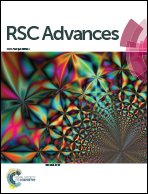Non-invasive imaging of breast cancer using RGDyK functionalized fluorescent carbonaceous nanospheres†
Abstract
Fluorescent carbonaceous dots (CDs) have attracted much attention due to their unique properties. However, their application in non-invasive imaging of diseased tissues was restricted by the short excitation/emission wavelength and the poor targeting efficiency of CDs. In this study, CDs were prepared from sucrose and glutamic acid with a particle size of 57.5 nm. An obvious emission could be observed at 600 nm to 700 nm when excited at around 500 nm. This property enabled CDs with a capacity for deep tissue imaging with low background adsorption. RGD, a ligand which could target most tumor and neovasculature cells, was anchored onto CDs after PEGylation. The product, RGD–PEG–CDs could accumulate in MCF-7/ADR xenografts at high intensity, which was 1.65-fold higher than that of PEG–CDs. Furthermore, RGD–PEG–CDs showed good colocalization with neovasculature. Thus, RGD–PEG–CDs could be used for non-invasive MCF-7/ADR tumor imaging. CDs functionalized with other ligands may also be used as a non-invasive probe for many kinds of tumor imaging.


 Please wait while we load your content...
Please wait while we load your content...